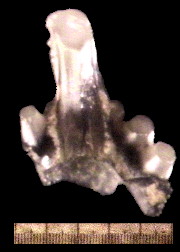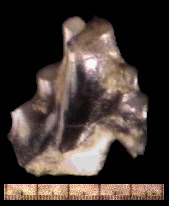2. Element Clusters
Go back to Analysis: Research In Progress
Studies of small, well mixed shale samples sometime seem to show clusters
of elements. Such clusters could be created by:
-
1 . the feces of a conodont eating animal
-
2. anomalous concentration of conodonts into clusters by natural
processes such as erosion
-
3. Tendencies of conodonts to stick together
-
4. Natural assemblages left behind from individual dead animals.
-
5. Observer bias
Some elements found in the same cluster show similar sizes and wear patters
that suggest they might be from the same organism. To study the distribution
of conodonts small samples of varying sizes were studied and the conodonts
counted, and the yield in conodonts/gram was determined. Conodont
clusters will appear in the data as repeated peaks on the yield curve,
and as a change in variability based on sample size in the scatter diagram.
At this time, these data appear to be indeterminate.

A typical cluster of conodonts from a sample containing similar
elements:
Sample C37BD
C37AZ50 -- 
 --
C37AZ51
--
C37AZ51
C37AZ53 -- 
 -- C37AZ54
-- C37AZ54
C37AZ55 -- 
 -- C37AZ52
-- C37AZ52
Comment: Total of 8 conodonts recovered from sample -- including
6 pictured above. Not shown: a 6-denticulated rastrate element (48)
, and a second crushing nub-like elements(49) . Elements 50, 51 and
52 were almost touching one another. Unfortunately, specimens C37AZ49
and 53 were lost during photography sessions..
Page established 3-3-98, updated 6-8-99 -- copyright Jim Davison
Go back to: Analysis: Research In Progress--
Please mail comments or suggestions to: jamesdavison@home.com



 --
C37AZ51
--
C37AZ51

 -- C37AZ54
-- C37AZ54

 -- C37AZ52
-- C37AZ52